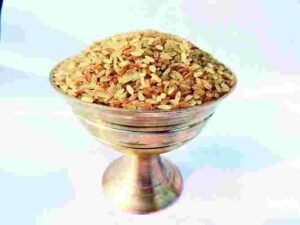1. Introduction
Boka Chaul, also known as “Magic Rice,” is an indigenous rice variety of Assam, India.

Recognized for its unique characteristics and culinary significance.
2. Name and Meaning of Boka Chaul
Boka Chaul translates to “soft rice” in Assamese.
“Boka” means “mud”, reflecting its soft texture, while “Chaul” means rice.
3. Description of Boka Chaul
| Feature | Details |
|---|---|
| Grain Type | Short-grained, parboiled rice. |
| Cooking Method | Requires no conventional cooking; softens when soaked in lukewarm (30 min) or cold water (1 hour). |
| Amylose Content | 12% to 17% (compared to regular rice, which has 20%-25%). |
| Texture | Soft, easily digestible. |
4. Nutritional Profile of Boka Chaul
| Nutrient | Percentage |
| Protein | 6.8% |
| Fiber | 10.73% |
Considered “default organic”, as it is grown without chemical fertilizers and follows sustainable farming practices.
5. Cultivation of Boka Chaul
Primarily cultivated in the Lower Brahmaputra Valley Zone.
Major districts:
Dhubri, Kokrajhar, Chirang, Bongaigaon, Goalpara, Barpeta, Nalbari, Baksa, Kamrup Rural, Kamrup Metropolitan, Darrang, Udalguri.
Thrives in fertile alluvial soils enriched by the Brahmaputra River.
6. Cultural Significance of Boka Chaul
Served as a crucial food source for Ahom soldiers during the 17th-century Mughal invasions.
Consumed during religious ceremonies and Assamese festivities.
Commonly paired with curd, jaggery, or other accompaniments in traditional meals.
7. Culinary Uses of Boka Chaul
Can be eaten as:
Standalone dish.
Breakfast cereal.
Mixed with curd or jaggery for a nutritious meal.
Favored in summer months for its cooling properties.
8. Geographical Indication (GI) Tag
| Parameter | Details |
| GI Certificate Awarded | December 11, 2024 |
| Significance | Protects unique identity, promotes cultivation & commercialization |
9. Conclusion
Boka Chaul is an integral part of Assamese culture and cuisine.
Offers nutritional benefits, historical importance, and a unique preparation method.
The GI tag enhances recognition, supports local farmers, and ensures preservation of this traditional variety.
Let us know any further suggestions ,we at sudurbhai.com will be happy to hear from you in our comment section below !
